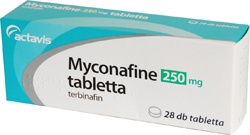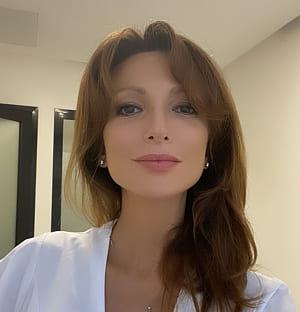

Miconafine

Ask a doctor about a prescription for Miconafine

How to use Miconafine
Package Leaflet: Information for the User
Myconafine, 250 mg, tablets
Terbinafine
Read the package leaflet carefully before taking the medicine, as it contains important information for the patient.
- Keep this leaflet, you may need to read it again.
- If you have any further questions, ask your doctor or pharmacist.
- This medicine has been prescribed for you only. Do not pass it on to others. It may harm them, even if their symptoms are the same as yours.
- If you get any side effects, talk to your doctor or pharmacist. This includes any possible side effects not listed in this leaflet. See section 4.
Table of Contents of the Leaflet
- 1. What is Myconafine and what is it used for
- 2. Important information before taking Myconafine
- 3. How to take Myconafine
- 4. Possible side effects
- 5. How to store Myconafine
- 6. Contents of the pack and other information
1. What is Myconafine and what is it used for
Myconafine contains terbinafine, which has antifungal effects. Terbinafine kills fungi by destroying their cell membranes.
Myconafine is used to treat fungal infections of the toenails and fingernails, athlete's foot, jock itch, and ringworm.
2. Important information before taking Myconafine
When not to take Myconafine
- If you are allergic to terbinafine or any of the other ingredients of this medicine (listed in section 6).
- If you have severe liver or kidney disease.
Warnings and precautions
Before taking Myconafine, discuss with your doctor if you have:
- Psoriasis (a skin disease characterized by scaly skin). Myconafine may worsen the disease.
- Systemic lupus erythematosus (an autoimmune disease).
Contact your doctor immediately if you experience:
- Sudden high fever or sore throat.
Myconafine and other medicines
Tell your doctor or pharmacist about all medicines you are taking, have recently taken, or might take.
This is important because Myconafine may interact with other medicines. This may increase or decrease the effect of other medicines.
If you are taking any of the following medicines, your doctor may change the dose of Myconafine or the other medicine:
- Rifampicin (a medicine used to treat tuberculosis).
- Cimetidine (a medicine used to treat stomach ulcers).
- Tricyclic antidepressants, selective serotonin reuptake inhibitors, and monoamine oxidase inhibitors (medicines used to treat depression).
- Beta-blockers and anti-arrhythmic medicines (medicines used to treat high blood pressure and certain heart conditions).
- Caffeine.
- Cyclosporin (a medicine used to prevent rejection of transplanted organs).
- Fluconazole and ketoconazole (medicines used to treat fungal infections).
If you are taking oral contraceptives while taking Myconafine, you may experience irregular menstrual bleeding or intermenstrual bleeding.
Myconafine with food and drink
Food does not affect the action of Myconafine, so you do not need to take the tablets with a meal.
Pregnancy, breastfeeding, and fertility
If you are pregnant or breastfeeding, think you may be pregnant, or are planning to have a baby, ask your doctor or pharmacist for advice before taking this medicine.
Do not take Myconafine if you are pregnant, unless your doctor considers it necessary.
Do not take Myconafine if you are breastfeeding, as terbinafine passes into breast milk.
Driving and using machines
Myconafine has no or negligible influence on the ability to drive and use machines. However, patients who experience dizziness should avoid driving and using machines.
3. How to take Myconafine
Always take this medicine exactly as your doctor has told you. If you are not sure, ask your doctor or pharmacist.
The recommended dose of Myconafine for adults, including elderly patients, is 250 mg once a day (1 tablet of Myconafine).
Duration of treatment
The duration of treatment depends on the location and severity of the infection and is:
- Fungal infections of the groin and skin (ringworm): in most cases, the treatment duration is 2-4 weeks.
- Fungal infections of the feet, between the toes, and athlete's foot: the treatment duration may be up to 6 weeks.
- Fungal infections of the fingernails: in most cases, the treatment duration is 6 weeks.
- Fungal infections of the toenails: the treatment duration is usually 12 weeks, but in some cases up to 6 months.
Use in children and adolescents (under 18 years)
There is no information on the use of this medicine in children and adolescents under 18 years.
Do not give Myconafine to children, unless your doctor has prescribed it.
Overdose
If you have taken more than the prescribed dose of Myconafine, contact your doctor or hospital immediately.
Symptoms of overdose include headache, nausea, abdominal pain, and dizziness.
Missed dose
If you forget to take a dose, take it as soon as you remember. If it is almost time for your next dose, skip the missed dose and take the next dose at the usual time. Do not take a double dose to make up for a missed dose.
Stopping treatment
Your doctor will tell you how long to take Myconafine. Do not stop treatment before completing the prescribed course, as the infection may not be completely cured. It may take several weeks after completing treatment for all symptoms to disappear.
If you have any further questions on the use of this medicine, ask your doctor or pharmacist.
4. Possible side effects
Like all medicines, this medicine can cause side effects, although not everybody gets them.
The following side effects are serious and require immediate action. Stop taking Myconafine and contact your doctor if you experience:
˗
Swelling of the face, tongue, and throat, which may cause difficulty breathing (angioedema).
˗
Sudden allergic reaction with shortness of breath, rash, wheezing, and low blood pressure (anaphylactic reaction).
˗
Severe skin reaction, such as severe allergic reaction with fever, joint pain, and (or) eye inflammation, blisters on the skin, or skin peeling (Stevens-Johnson syndrome, toxic epidermal necrolysis).
˗
Yellowing of the skin or eyes, dark urine, pale stools, nausea, loss of appetite, fatigue, vomiting, abdominal pain (symptoms of liver problems, such as jaundice, hepatitis, cholestasis, or liver failure).
The following side effects may also occur:
Very common side effects (may affect more than 1 in 10 people):
Mild skin reactions, such as rash and hives. Skin reactions may be accompanied by joint and muscle pain. You may also experience: feeling of fullness in the stomach, indigestion, nausea, abdominal pain, diarrhea, decreased appetite.
Common side effects (may affect up to 1 in 10 people):
Headache.
Uncommon side effects (may affect up to 1 in 100 people):
Taste disturbances, including loss of taste. This condition usually resolves slowly after stopping treatment.
In rare cases, permanent taste disturbances have been observed.
Rare side effects (may affect up to 1 in 1,000 people):
Increased liver enzyme activity, general feeling of being unwell, fatigue. Numbness and tingling of the skin, or prickling and tingling (paresthesia), decreased sensitivity to touch or feeling of numbness, dizziness.
Very rare side effects (may affect up to 1 in 10,000 people):
Red, irregular patches on the skin of the hands and arms (erythema multiforme). Changes in blood cell counts, severe immune system disease with skin symptoms (systemic lupus erythematosus), worsening of psoriasis symptoms (a skin disease characterized by scaly skin), hair loss, sudden appearance of red, swollen areas on the skin with numerous blisters (acute generalized exanthematous pustulosis). Symptoms of severe mental disorders, such as depression and anxiety.
Frequency not known (cannot be estimated from the available data):
Anemia, loss of sense of smell (anosmia), moderate to severe allergic reactions (reaction similar to serum sickness and anaphylactic reaction), hearing loss (hypacusis), hearing disturbances (tinnitus), vasculitis, pancreatitis.
Moderate to severe allergic reactions caused by sunlight, muscle pain and damage (rhabdomyolysis), weight loss due to decreased food intake, flu-like illness, fever, increased creatine kinase levels in the blood.
Reporting side effects
If you experience any side effects, including those not listed in this leaflet, tell your doctor or pharmacist, or nurse.
Side effects can be reported directly to the Department of Drug Safety Monitoring of the Office for Registration of Medicinal Products, Medical Devices, and Biocidal Products:
Al. Jerozolimskie 181C, 02-222 Warsaw, tel.: 22 49-21-301, fax: 22 49-21-309, e-mail:
[email protected].
Side effects can also be reported to the marketing authorization holder.
Reporting side effects will help to gather more information on the safety of this medicine.
5. How to store Myconafine
Keep this medicine out of the sight and reach of children.
Do not use this medicine after the expiry date stated on the carton after EXP. The expiry date refers to the last day of that month.
There are no special storage precautions.
Medicines should not be disposed of via wastewater or household waste. Ask your pharmacist how to dispose of medicines no longer required. This will help protect the environment.
6. Contents of the pack and other information
What Myconafine contains:
- The active substance is terbinafine, in the form of terbinafine hydrochloride. One tablet contains 250 mg of terbinafine (in the form of terbinafine hydrochloride).
- The other ingredients are: microcrystalline cellulose, sodium croscarmellose, colloidal anhydrous silica, hypromellose, and magnesium stearate.
What Myconafine looks like and contents of the pack
White, round, flat tablets, 11 mm in diameter, with a score line on both sides, with the letter "T" above the score line and the number "1" below the score line on one side.
Myconafine is available in the following pack sizes:
Blisters: 7, 14, 28, 56, and 112 tablets in blisters, in a cardboard box.
Bottles: 50 and 100 tablets in bottles.
Not all pack sizes may be marketed.
Marketing authorization holder and manufacturer
Marketing authorization holder:
Aristo Pharma Sp. z o.o.
Baletowa 30
02-867 Warsaw
Manufacturer:
Actavis Ltd.
BLB015-016 Bulebel Industrial Estate
Zejtun ZTN3000
Malta
Date of last revision of the leaflet:January 2020
- Country of registration
- Active substance
- Prescription requiredYes
- Manufacturer
- ImporterActavis Ltd.
- This information is for reference only and does not constitute medical advice. Always consult a licensed doctor before taking any medication. Oladoctor is not responsible for medical decisions based on this content.
- Alternatives to MiconafineDosage form: Tablets, 250 mgActive substance: terbinafineManufacturer: Polfarmex S.A.Prescription requiredDosage form: Tablets, 125 mgActive substance: terbinafinePrescription requiredDosage form: Tablets, 250 mgActive substance: terbinafineManufacturer: Lek d.d., PE PROIZODNJA LENDAVA Novartis Farmaceutica S.A. Novartis Pharma GmbH Novartis Poland Sp. z o.o.Prescription required
Alternatives to Miconafine in other countries
The best alternatives with the same active ingredient and therapeutic effect.
Alternative to Miconafine in Ukraine
Alternative to Miconafine in Spain
Online doctors for Miconafine
Discuss dosage, side effects, interactions, contraindications, and prescription renewal for Miconafine – subject to medical assessment and local rules.







